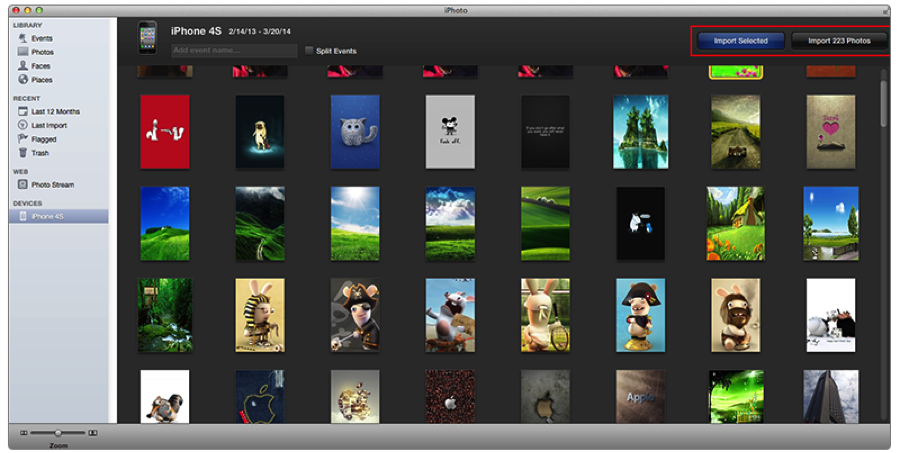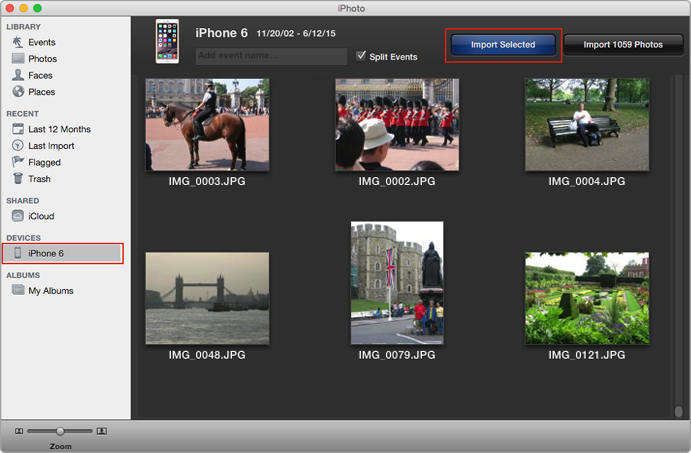I am trying to move my photos from my 4 year old Macbook to my Mac, both of which have iPhoto 11. I was going to do it via firewire, but my laptop doesn’t have a connection. Is there a way I can use an adapter and go through a usb port? If not, what is the easiest way to complete the transfer? I am not a very technology-savvy guy…
While iPhoto Library Manager for Mac does not advertise itself as a photo editor, some basic editing features would have been a welcome addition to the program, rather than simply directing the.
Thanks!
- Aug 16, 2018 How to Transfer iPhoto Library to Photos App on Mac OS X Yosemite. Dhvanesh Adhiya. Photos app has more user-friendly features to let you manage your photos in an all-new way. The best part is that the Photo Library is almost identical to that of iOS 8’s regarding functionality. How to Transfer iPhoto Library to Photos App on Mac OS X.
- Migration assistance does not handle the iPhoto library well sometimes - the best way is to drag the bad iphoto library from the pictures folder on the new system to the desktop, connect the two systems together (network, firewire target mode, etc) and drag the iPhoto library intact as a single entity from the old system to the pictures folder.
To move an iPhoto Library to a new machine you will have to link the two Macs together either by a Wireless Network, Firewire Target Disk Mode, Ethernet, or even just copy the iPhoto Library from the Pictures Folder to an external HD and then on to your new Mac… Then launch iPhoto. That’s it.
but if u have a fast enough internet connection then ill suggest i cloud...
Copy the file named iPhoto library in the photos folder on one mac and and paste it on the other one in the same location. (use a usb stick)
Sync your iPhoto libraries -
Also,if you like to have a online backup too,then -
The iPhoto library is actually a folder which your Mac shows as a file.
It's located in the /Users/username/Pictures folder and it's called iPhoto Library.
You can just copy the whole folder onto a hard drive or move it via Ethernet/Wi-Fi and put it in the same folder on your new Mac and it will be there.
To move an iPhoto Library to a new machine you will have to link the two Macs together either by a Wireless Network, Firewire Target Disk Mode, Ethernet, or even just copy the iPhoto Library from the Pictures Folder to an external HD and then on to your new Mac... Then launch iPhoto. That's it.
You will see all your photos, events, albums, books, keywords, slideshows and everything else in your new Mac. But if you already have an iPhoto Library in your new Mac and want to merge it with your old library, the only way to do it is with the paid version of iPhoto Library Manager costing $20.
You can download it at this link: http://www.fatcatsoftware.com/iplm/. Good luck
how about to transfer to external hard drive and then to copy to new mac.
if you can buy a firewire card?
How to use and troubleshoot FireWire target disk mode
http://support.apple.com/kb/HT1661Ethernet Cable
How to Transfer From a PowerBook G4 to a MacBook Pro 13
http://www.ehow.com/how_8370279_transfer-g4-macbook-pro-13.html#ixzz2ACUV5bWDvia dropbox
https://www.dropbox.com/
iPhoto is a part of iLife software application suite, which not only helps you organize and edit your photos, but also lets you get more from these photos by making photo books, greeting cards and slideshows. iPhoto will generates a iPhoto Library folder or package that contains imported photos and any albums you've added using iPhoto.
If you want to move iPhoto Library to a new location or new computer, you must move the entire iPhoto Library folder or package and then identify its new location in iPhoto.
How to Move iPhoto Library to a New Location / Computer
Now you want to move iPhoto Library to a new location in internal drive of Mac computer (frankly, I don't know why, maybe you just want). Other cases include that you run out of hard drive space in Mac (Mountain Lion included) due to the high resolution photos taken by camera, or you just bought a new Mac computer (Mac OS X 10.11 included). Well, see how to move iPhoto Library to a new location or your new computer (using external hard drive). The solution is very similar.
1. Exit iPhoto if open.
2. Open your Pictures folder and select the iPhoto Library.
3a.For a new location: Drag the iPhoto Library folder or package to its new location.
3b.For a new computer: Connect your external hard drive which will display on Finder. Drag the iPhoto Library folder or package to external hard drive.

4. Now open iPhoto (the new computer for moving iPhoto Library to a new computer). Hold down the Option key on the keyboard, and keep the Option key held down until you are prompted to create or choose an iPhoto library.
5. Click Choose Library.
6. Locate and select the iPhoto Library you moved in step 3.
7. Now you will see the photos in the new iPhoto Library or in a new computer's iPhoto Library.
8. Delete the original iPhoto Library if necessary.
9. Moving iPhoto Library complete.
Note: If deleting the old library from the computer's hard drive makes you nervous, you can backup iPhoto to CD/DVD by clicking Share -> Burn before you erase anything.
More about Moving iPhoto Library:
1. The iPhoto library thumbnail is different between pre-iPhoto '08 and post-iPhoto '08. The iPhoto library in iPhoto '08 or later is called a package. See below:

2. You could also move iPhoto library to an external hard drive for backup purpose.
3. Move, delete, rename, or change files or folders in the iPhoto Library folder may make you unable to see your pictures. To slove this problem, you can restore your iPhoto library backup (if exists), or change it back to the original one.
How To Transfer Iphoto Library To New Macbook Pro
4.There are also applications to help you move iPhoto Library safely, such as iPhotoLibraryManager or iPhotoBuddy.